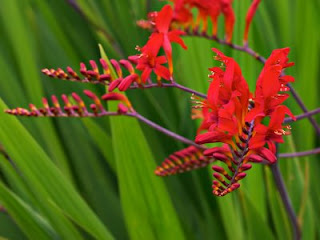
--
A friend forwarded this photograph of Air Force One on the tarmac at Tri-Cities regional airport. Prior to its most recent renovation, our local airport looked more like a bus terminal than an airport and even now it features a whopping 7 departure gates and flies nonstop to a total of 7 cities.
--
So you can see why this photograph documents a rather momentous occasion. President Obama was here to give a town hall style speech at one of our local grocery stores. It happens to be the one I shop most often, the Bristol Kroger.
--

--
In the days preceding the president's visit, the store went through the kind of cleaning and polishing that most of us would perform if the mother-in-law was coming for an out-of-town overnight visit-- more even, as they had more manpower. Peeling, exposed duct work was repainted and workers broke out toothbrushes to clean surfaces on the numbered lights above checkout aisles.
--

--
ABC news said the president delivered remarks on the economic recovery, but in reality he spent most of the hour providing an explanation of the health care proposals currently underway in Washington.
--
I went shopping the evening after the President's visit and found the staff response to the visit intriguing.
--
The store had been closed from noon until 6 pm for the approximately one hour event. Attendance was by invitation only and grocery store employees comprised the vast majority of guest list.
--

(not my actual cashier)
--
My cashier said the president was a really good speaker, but supposed that came with the territory. (Oh, how quickly people forget.) She also commented on how he could make one believe what he was saying. Now I may be misinterpreting, but I heard a tone in the cashier's voice that indicated that she thought this was some kind of sneaky trickery. And silly me, my thoughts were that transparently had been the president's primary purpose in bringing his message to the people in this forum.

(not my actual groceries)
--
My grocery bagger offered the observation that the president seemed like a real nice guy, but indicated he thought the man might be all talk and no action. All in all, quite interesting interpretations.
--
*Warning, political opinion espoused below *
--
In one study I read, the health insurance industry is spending on order of 1.4 million dollars per day to fight health care reform. The industry has contributed 372 million dollars to politicians of both parties in the past nine years. They run an industry constructed to generate profits, not to promote the health of its customers.
--
While many people doubt the government’s ability to perform tasks effectively, we don't clamor for the privatization of government functions like the military. In fact we have seen what a pitiful job private military corporations have done by looking at the performance of Blackwater.
--
We would at least find a difference in mission with the provision of a public health insurance option. The government would be charged with the mission of providing health care instead of profits as its primary objective.
--
The United States spends 16% of its GNP (Gross National Product) on health care, yet leaves an estimated 45.7 million of its citizens uninsured. France and Germany spend 11-12% of their GNP and achieve universal coverage. Polls of public opinion generally find that France has the population most satisfied with their health care options. We are watching a battle that has happened repeatedly.
--
It is amazing that we ever got that other government run health care program, Medicare, off the ground. It was heavily opposed when it came into being in the mid 1960's.
--
Hopefully, at some point in the not-too-distant future we will be able to change the date on this Shepard Fairey poster and apply it to the health care situation.
--
Carina







































